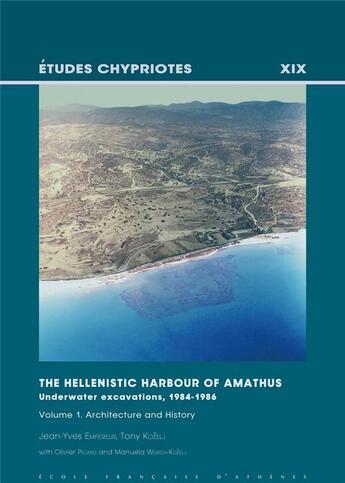Résumé:
Nous livrons ici le résultat des trois campagnes de la fouille sous-marine du port d'Amathonte de Chypre en 1984-1986, exceptionnel monument d'architecture militaire de la haute époque hellénistique. Après une description de la vingtaine de sondages entrepris le long des môles, on trouvera une... Voir plus
Nous livrons ici le résultat des trois campagnes de la fouille sous-marine du port d'Amathonte de Chypre en 1984-1986, exceptionnel monument d'architecture militaire de la haute époque hellénistique. Après une description de la vingtaine de sondages entrepris le long des môles, on trouvera une nomenclature des blocs mis en oeuvre dans la construction, leurs modules, la typologie des systèmes de préhension pour leur levage ainsi que pour leur mise en place par une grue à flèche verticale qui progressait au fur et à mesure de la construction du môle. On décrira les carrières voisines dans lesquelles ont été retrouvés les négatifs des blocs employés dans les môles. Les monnaies contribuent à attribuer la construction à Démétrios Poliorcète après sa victoire navale à Salamine en 306 avant J.-C. et l'abandon lors de la reprise de l'île par Ptolémée Ier en 294.
Dans une seconde partie, nous étudions les puits romains tardifs fouillés sur le côté nord du bassin, témoins des forts changements du niveau marin.
We present here the results of three underwater excavation campaigns conducted between 1984 and 1986 on the harbour of Amathus, Cyprus, an exceptional monument of military architecture from the Early Hellenistic era. After a description of the twenty sondages undertaken along the moles, there follows a nomenclature of the blocks employed in the construction, their modules, the typology of bosses for hoisting and placing by a vertical boom crane, which gradually advanced along the mole as it was being built. We describe the nearby quarries in which negatives of the blocks used in the moles were found. The coins have pointed to the attribution of the construction to Demetrius Poliorcetes after his naval victory at Salamis in 306 BC, and the abandonment during the reconquest of the island by Ptolemy I in 294.
In the second part, we study the Late Roman wells that were excavated on the north side of the harbour basin, which testify to large changes in sea level.
Donner votre avis















